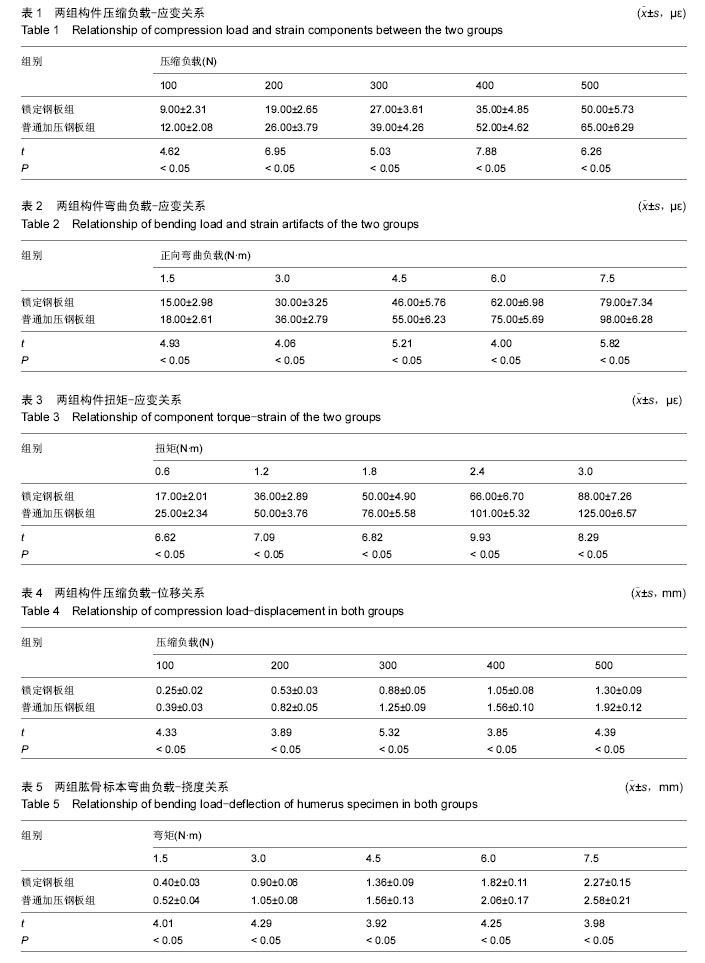| [1] Tyllianakis M,Tsoumpos P,Anagnostou K,et al. Intramedullary Nailing of Humeral Diaphyseal Fractures. Is Distal Locking Really Necessary?Int J Shoulder Surg. 2013;7(2):65- 69.
[2] Lee HJ, Oh CW, Oh JK, et al. Minimally invasive plate osteosynthesis for humeral shaft fracture: a reproducible technique with the assistance of an external fixator. Arch Orthop Trauma Surg. 2013; 133(5): 649-657.
[3] 张林根. 锁定加压钢板在四肢骨折治疗中的临床应用分析[J]. 当代医学,2012,18(2):120-121.
[4] 钱学渊. 微创经皮锁定加压钢板内固定治疗四肢粉碎骨折的临床研究[J]. 中国医药导报,2012,9(3):57-58.
[5] 石争利. 锁定加压钢板在四肢骨折患者中的应用及临床价值分析[J].吉林医学,2013,34(7):1257-1258.
[6] Oh CW, Byun YS, Oh JK, et al. Plating of humeral shaft fractures:comparison of standard conventional plating versus minimally invasive plating. Orthop Traumatol Surg Res. 2012;98(1):54-60.
[7] 梁柱天.锁定钢板与交锁髓内钉治疗股骨干骨折的临床研究[J].安徽医学,2012,33(7):456-457.
[8] 秦超. 短节段椎弓根钉内固定治疗胸腰段脊柱骨折脱位临床研究[J].中国实用医药,2013,4(9):45-46.
[9] 段玉才.锁定加压钢板治疗四肢骨折的疗效分析[J].大家健康, 2014,8(6):90-91.
[10] 计石贵. 短节段椎弓根螺钉治疗40例胸腰段脊柱爆裂性骨折的临床分析[J]. 中外医疗,2013,12(3):79-80.
[11] 张帆.手法复位结合中医药疗法治疗小儿肱骨踝上骨折的效果观察[J].中国临床研究,2012,4(22):76-77.
[12] 姚琦,仇永辉,倪杰,等. 锁定钢板内固定术与半肩关节置换术治疗老年人肱骨近端粉碎骨折效果的对照研究[J]. 中华老年多器官疾病杂志,2014, 13(7): 489-493.
[13] 苗雨后.中医方法治疗肱骨踝上骨折疗效分析[J].中国卫生产业,2012,9(30):172-173.
[14] 詹远平. 锁骨钩钢板治疗锁骨远端骨折和肩锁关节脱位18例疗效观察[J]. 中国医药指南,2013,14(7):550-551.
[15] Maier D, Jaeger M, Izadpanah K, et al. Proximal humeral fracture treatment in adults. J Bone Joint Surg Am. 2014;96(3): 251-261.
[16] Baltov A,Mihail R,Dian E. Complications After Interlocking Intramedullary Nailing of Humeral Shaft Fractures. Injury Int J Care Injured. 2014;45 (1):s9- s15.
[17] 唐秀锦.锁骨钩钢板治疗锁骨远端骨折和肩锁关节脱位的疗效观察[J].中国医药指南,2012,28(22):205-206.
[18] 胡振伟. AO锁骨钩钢板与克氏针张力带钢丝治疗锁骨远端骨折的疗效分析[D].大连医科大学,2012.
[19] 高宏梁,管国华,黄胜,等.内外侧小切口治疗儿童肱骨踝上 GartlandⅢ型骨折[J].临床骨科杂志,2012,15(1):93-94.
[20] 蒋玉荣,吴东敏,莫贤跃,等.闭合复位经皮克氏针内固定治疗儿童肱骨踝上骨折[J].中国卫生产业,2012,9(21): 128-129.
[21] 陈辉强,章莹,夏虹.数字骨科技术辅助治疗胫骨Pilon骨折的临床应用[J].中国矫形外科杂志,2013,21(20): 2030-2034.
[22] 程艳华.人工全髋关节置换术的围手术期护理体会[J].河南外科学杂志,2014,20(1):147-148.
[23] Yi JW,Oh JK,Han SB,et al. Healing Process After Rigid Plate Fixation of Humeral Shaft Fractures Revisited. Arch Orthop Trauma Surg. 2013;133(6):811- 817.
[24] Spross C, Platz A, Rufibach K, et al. The PHILOS plate for proximal humeral fractures-risk factors for complications at one year. J Trauma Acute Care Surg. 2012;72(3): 783-792.
[25] 王亦璁.骨与关节损伤[M].北京:人民卫生出版社,2010: 756-757.
[26] 夏晖,王坤善,韩峰,等.小切口前置锁定钢板治疗肱骨干中下段斜型及螺旋形骨折的临床疗效分析[J].中国现代医药杂志,2015,17(7):110-111.
[27] van der Meijden OA,Gaskill TR,Millett PJ. Treatment of clavicle fractures:current concepts review. J Shoulder Elbow Surg. 2012;21(3): 423-429.
[28] 艾进伟,韩叶萍,李沛,等. 外固定支架治疗复杂肱骨干骨折的疗效观察[J].中外医疗,2013,32(9):77-78.
[29] Steffner RJ,Lee MA. Emerging Concepts in Upper Extremity Trauma:Humeral Shaft Fractures. Orthop Clin North Am. 2013;(44):21-33.
[30] 范鑫斌,张岩,杨铁毅,等.胫骨平台后外侧骨折3种内固定方式的有限元分析[J].中国组织工程研究,2014,18(22): 345-346.
[31] Kumar MN,Ravindranath VP,Ravishankar M. Outcome of locking compression plates in humeral shaft nonunions. Indian J Orthop. 2013;47(2):150-155.
[32] 王军强,赵春鹏,龚晓峰,等.锁定加压接骨板内固定结合自体髂骨植骨治疗肱骨干骨折术后骨不连[J].中华创伤骨科杂志, 2012,14(2):127-131.
[33] Dai J,Chai Y,Wang C,et al. Dynamic Compression Plating Versus Locked Intramedullary Nailing for Humeral Shaft Fractures:A Meta- Analysis of RCTs and Nonrandomized Studies. J Orthop Sci. 2014;19(2): 282- 291.
[34] Liu GY,Zhang CY,Wu HW. Comparison of initial nonoperative and operative management of radial nerve palsy associated with acute humeral shaft fractures. Orthopedics. 2012;35(8): 702-708.
[35] 马湘毅,潘西庆,李峰,等.顺行交锁髓内钉在治疗肱骨干骨折中对肩袖的影响[J].中国骨与关节损伤杂志,2013, 28(7):667-668.
[36] Lieber J,Schmittenbecher P. Developments in the Treatment of Pediatric Long Bone Shaft Fractures. Eur J Pediatr Surg. 2013;23(6):427-433.
[37] 曹烁华,霍力为. 手法复位配合小夹板治疗肱骨干骨折 28例临床体会[J].中国民族民间医药,2014,23(2):74.
[38] 刘平,邢丽娅,赵凤,等. 可膨胀髓内钉治疗肱骨干骨折的临床疗效[J]. 中国骨与关节损伤杂志,2013,28(9):868.
[39] 唐献忠,梁朝革,蔡振宇,等. 交锁髓内钉内固定治疗肱骨干骨折[J]. 中国骨与关节损伤杂志,2012,23(3):257-258.
[40] Kapil MK,Gopal SD,Rijal L,et al. Study On Outcome of Fracture Shaft of the Humerus Treated Non- Operatively with a Functional Brace. Eur J Orthop Surg Traumatol. 2013;23(3):323-328. |
.jpg)


.jpg)
.jpg)
.jpg)